

Zion Adventures - Trans-Zion Trek. Andrew Skurka - Zion Traverse. The first time I visited Zion National Park was in 1993, during a Skurka family summer vacation out West.

The unquestionable highlight of our stay there was a short day-hike up the Narrows, the towering walls and flash flood potential of which intrigued me to say the least. Sadly, and almost strangely, since that family vacation I had never been back to Zion despite my extensive travels around the West. So I jumped at the opportunity to join a group of 18 Boulderites—i.e., residents of the Republic of Boulder, CO—who were heading out there in early-May 2009 in order to explore some nearby canyons and to run 48 miles across the park.
The run was inspired by Jared Campbell and Karl Metzler, who did this route (for the first time ever as a trail run, as far as I know) in April 2008. I would describe this run—which can also be done as a long day-hike or as a multi-day backpacking trip—as “highly recommended.” Stuck in the Rockies - Zion Traverse Report. Through some of the narrows on the descent from the East Rim to Weeping Rock.

We ran the Zion Traverse last week– a linkup of existing trails across Zion National Park that measures about 48 miles and reportedly gains around 10,000 vertical feet. Christy and I are big fans of established courses such as the Grand Canyon Rim-to-Rim (or roundtrip) and the Four Pass Loop, so it was time to check out this increasingly popular route. The course essentially runs diagonally across Zion N.P., and can be done in either direction. After doing a little research online (Andrew Skurka’s site has the best breakdown of it), we opted to start at the East Rim Trailhead and head northwest to Lee Pass. There are pros and cons to going in either direction and we based our decision largely on the elevation profile, we opted to take on the biggest descent/climb of the route early rather than late in the day. Joe Skeens - El Malpais NCA - Grants, New Mexico. Have you been there?
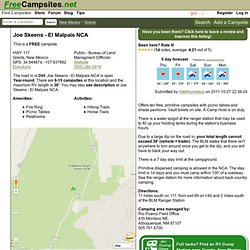
Click here to leave a review and improve this listing! Been here? Rate it! Loading ... Offers ten free, primitive campsites with picnic tables and shade pavilions. There is a water spigot at the ranger station that may be used to fill up your holding tanks during the station's business hours. Due to a large dip on the road in, your total length cannot exceed 36' (vehicle + trailer). Favorite Grand Canyon Campgrounds. After 10 miles of hiking under the scorching Arizona sun, you will finally make it to this Eden-like spot on the Havasupai Indian Reservation.
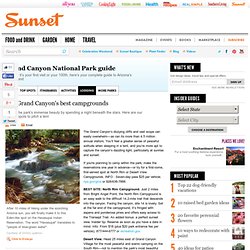
The word "Havasupai" translates to "people of blue-green water". Courtesy of Dmitry Lyakhov Click to Enlarge The Grand Canyon’s dizzying cliffs and vast scope can easily overwhelm―as can its more than 4.5 million annual visitors. You’ll feel a greater sense of peaceful solitude when sleeping in a tent, and you’re more apt to capture the canyon’s dazzling light, particularly at sunrise and sunset. Yavapai Point - About. View from Yavapai Point, Grand Canyon NP. Yavapai Point - Grand Canyon Village - Sightseeing. Make your Reservation or call: 1.888.297.2757 Things to Do.
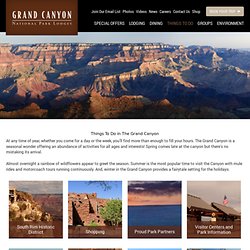
Giant Tee Pee, Lupton, Arizona. Lupton, Arizona Is a giant tee pee more authentic if it is found on a authentic Indian reservation?

Built in 1982, the Tee Pee Trading Post stood along old Route 66 when it opened -- apparently too late to save the famous highway, which was decommissioned three years later. At the time, the tee pee -- which stands 60 feet tall -- was known as the Tomahawk Indian Store and was painted flaming yellow. Despite Route 66's demise, traffic never slackened; this part of Arizona runs through a canyon, which means that Interstate 40 -- which parallels the old highway -- runs right alongside. Holbrook, AZ - Petrified Forest National Park. A horrible curse is said to befall anyone who removes a piece of petrified wood from inside the Park.

Lucky for you, there are gift shops just outside the Park, willing to sell you a chunk, a stump, or a whole log. Address: Flintstones Bedrock City, Williams, Arizona. Williams, Arizona The Bedrock City in Custer, South Dakota may be reassuring and freshly painted, but it's still in South Dakota -- only open from mid-May through Labor Day.
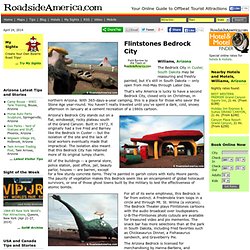
That's why America is lucky to have a second Bedrock City, closed only on Christmas, in northern Arizona. Stewart's Petrified Wood, Holbrook, Arizona. Holbrook, Arizona Petrified wood is the brown gold of northeastern Arizona.

It's a commodity that's scattered along the ground everywhere, and yet tourists will pay money to get some -- if you can get them to stop. And that's a problem. Today's overstimulated travelers -- snug in their cocoon of digital entertainment and satellite navigation -- aren't inspired to pull off of the highway by the clunky, 1950s-era art that advertises most petrified wood attractions: a fallen cartoon log, shattered into several smaller logs, its center eaten away by some Jurassic termite.
Which is why Charles Stewart is doing such good business. World's Largest Petrified Tree, Holbrook, Arizona. Holbrook, AZ - Painted Desert Indian Center. Meteor Crater - Barringer Crater, Winslow, Arizona. Winslow, Arizona Whenever a big enough rock tumbles from outer space and smacks into Earth, cataclysmic disaster is almost assured.
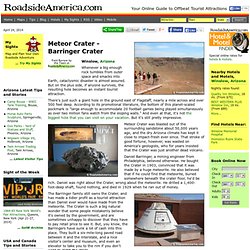
But on the plus side, if anyone survives, the resulting hole becomes an instant tourist attraction. There's just such a giant hole in the ground east of Flagstaff, nearly a mile across and over 500 feet deep. According to its promotional literature, the bottom of this planet-scaled pockmark is "large enough to accommodate 20 football games being played simultaneously as over two million fans watch from the sloping walls.
" And even at that, it's not the biggest hole that you can visit on your vacation. Meteor Crater was blasted out of the surrounding sandstone about 50,000 years ago, and the dry Arizona climate has kept it close to impact-fresh ever since. Grand Canyon National Park. Grand Canyon South Rim. Grand Canyon Things to Do Kids, Activities, Helicopter, Railway Tours. Grand Canyon Skywalk Glass Bridge. While not located in the Grand Canyon National Park, it is located in a smaller part of the same canyon system, offering a view like no other can. Owned and operated by the Hualapai Tribe, the Skywalk will be the first-ever cantilever shaped glass walkway to suspend more than 4,000 feet above the canyon’s floor and extend 70 feet from the canyon’s rim.
March 28, 2007 as the official public opening date of The Skywalk. Access to The Skywalk will run from dawn to dusk and will cost $25 per person in addition to the cost of a Grand Canyon Hualapai West entrance package. One hundred and twenty people will be allowed on the bridge at a time. Admittance is first come, first serve for walk up visitors; however, reservations can be made. Prior to the public opening in March, Grand Canyon Hualapai West will host a “First Walk” event for media and VIPs. Phantom Ranch. Phantom Ranch is a resort village within Grand Canyon National Park in Arizona.
It is located on the north side of the Colorado River near its confluence with Bright Angel Creek and Phantom Creek. Phantom Ranch - Phantom Ranch.pdf. Grand Canyon Lodging, Hotel, Vacation, Camping, Lodge, Tours. Phantom Ranch is a historic oasis nestled at the bottom of Grand Canyon. It is on the north side of the Colorado River tucked in beside Bright Angel Creek. Painted Desert Inn - Petrified Forest National Park. Hiking The Painted Desert. Found in: | Outside | Hiking | Where to Go | Shale badlands and petrified wood logs near Blue Mesa. Because petrified wood is a much harder rock than the surrounding shale layers, it resists erosion and often ends up on pedestals.
Ruins dating from about 1,000 years ago prove that people have long used and lived in the Painted Desert. Painted Desert Rim Trail, Painted Desert Inn at Kachina Point, Petrified Forest National Park - Painted Desert, Arizona. Painted Desert Rim Trail - 1.0 Miles Round-Trip The Painted Desert Rim Trail runs atop the north-facing rim of a lofty escarpment, below which the Painted Desert Unit sprawls across the horizon. The rim houses a small oasis of plants, shrubs and trees that are otherwise rare throughout the Park.
Stunningly beautiful in all directions, the high perch on which you're traveling yields commanding views of the entire district where rolling, colorful badland formations are interspersed with vast grasslands and lengthy washes. Painted Desert (Arizona) Petrified Forest National Park. Trails - Petrified Forest National Park. Walking the Rim Trail One of the best way to enjoy and experience Petrified Forest National Park is on foot. Designated trails range in length from less than a half-mile to almost three miles. Stay on designated trails in developed hiking areas. Off-trail hiking damages the fragile grassland environment and disturbs wildlife habitat, creating unsightly "social" trails.
Leaving the designated trail can also be hazardous for hikers due to loose rock and dangerous cliffs. Pets are allowed on the developed trails. Bicycles are not allowed on trails except for the half mile access trail that leads to the junction between the Long Logs and Agate House Trails. At this time, none of the developed trails meet ADA requirements. Trails - Petrified Forest National Park. Four Corners Monument. The Navajo Nation cordially welcomes you to one of our most unique landmarks - The Four Corners. This is the only place in the United States where four states intersect at one point: Arizona, New Mexico, Utah and Colorado. This location is very remote as you will experience when visiting. The original marker erected in 1912 was a simple cement pad, but has since been redone in granite and brass. The Visitor Center is open year round, and features a Demonstration Center with Navajo artisans.
Navajo vendors sell handmade jewelry, crafts and traditional Navajo foods nearby. Picnic tables and self-contained restrooms are available. Four Corners.